- PyTorch는 현재 가장 인기있는 딥러닝 라이브러리 중 하나입니다.
- 학습 세부 사항을 지정하기 위해 Callback으로 다양한 기능을 지원합니다.
- skorch는 PyTorch를 scikit-learn과 함께 사용할 수 있게 해 줍니다.
- skorch도 PyTorch callback을 이용할 수 있습니다.
- 글이 길어 세 개로 나눕니다.
- 세 번째로, skorch를 사용해 ML Pipeline을 완성합니다.
- 여러 callback으로 자세한 설정을 반영합니다.
3.2. skorch
- Colab에는 skorch가 기본으로 설치되어 있지 않습니다.
- 간단한 명령으로 skorch를 설치합니다.
1
!pip install skorch
3.2.1. preprocessor 포함 pipeline 작성
- 앞에서 만든
get_preprocessor()함수는 전처리 Pipeline을 출력합니다. - Pipeline을 연장해 이 뒤에 PyTorch로 만든 Neural Network를 덧붙입니다.
- 우리가 푸는 문제는 펭귄의 체중을 구하는 regression문제입니다.
skorch에서 제공하는
NeuralNetRegressor()로 PyTorch 신경망을 감쌉니다.loss function, optimizer 등은
NeuralNetRegressor()안에criterion,optimizer등의 매개변수를 사용해 입력합니다.optimizer=optim.Adam으로 Adam을 선택했습니다.PyTorch에서 Adam()안에 들어가던 매개변수
lr=1e-3은optimizer__lr=1e-3으로 바뀌어 들어갑니다.1
2
3
4
5
6
7
8
9
10
11
12import skorch
from skorch import NeuralNetRegressor
# skorch로 PyTorch neural network wrapping
net_sk = NeuralNetRegressor(Net(), device=device, verbose=1,
criterion=RMSELoss, # loss function
optimizer=optim.Adam, # optimizer
optimizer__lr=1e-3) # learning rate of the optimizer
# training
for epoch in range(300):
net_sk.fit(X_train_np, y_train.astype(np.float32).values.reshape(-1, 1))- 실행 결과 : 너무 길어서 out of memory 오류가 뜰 수 있습니다. 침착하게 새로 고침을 누르시면 됩니다.
- 또는,
verbose=1을verbose=0으로 바꾸시는 것도 방법입니다.1
2
3
4
5
6
7
8
9
10
11
12
13
14
15
16
17
18... (생략) ...
10 271.1115 286.5908 0.0111
Re-initializing module.
Re-initializing criterion.
Re-initializing optimizer.
epoch train_loss valid_loss dur
------- ------------ ------------ ------
1 272.8632 286.3571 0.0108
2 267.6815 285.4084 0.0145
3 268.0632 284.9375 0.0106
4 269.3830 284.9683 0.0104
5 270.7425 285.2378 0.0101
6 271.6377 285.5552 0.0108
7 271.9493 285.8589 0.0082
8 271.8214 286.1465 0.0080
9 271.4798 286.4032 0.0087
10 271.1165 286.5942 0.0088
학습이
model.fit()으로 잘 됩니다.NeuralNetRegressor로 한 번 감싼 것 만으로 scikit-learn API를 사용할 수 있게 되었습니다.X_train대신 전처리를 거친X_train_np를 입력했습니다.y_train대신으로는y_train.astype(np.float32).values.reshape(-1, 1)이 들어갔습니다.pandas Series에서 데이터 타입을 바꾸고, 값을 추출해서, shape을 바꾼 것입니다.
- 예측도
model.forward()대신model.predict()로 진행합니다.1
2
3
4
5
6
7# prediction
y_pred_train = net_sk.predict(X_train_np)
y_pred_val = net_sk.predict(X_val_np)
y_pred_test = net_sk.predict(X_test_np)
# parity plot
plot_parity3(net_sk, Xs=[X_train_np, X_val_np, X_test_np])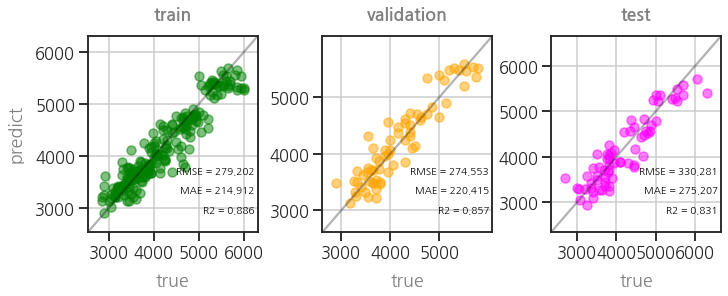
3.2.2. ML pipeline 작성
skorch: skorch.callbacks.InputShapeSetter
stackoverflow: How to pass input dim from fit method to skorch wrapper?
- 앞에서 만든 전처리기,
get_preprocessor()를 포함하는 Pipeline을 만듭니다. method매개변수로 neural network 뿐 아니라 linear regression, random forest를 선택할 수 있게 합니다.
Neural network는 이들 방법들과 달리 input dimension이 중요합니다.
신경망 구조를 만들 때 필요한 변수이기 때문입니다.
callback은 여러 설정을 지정할 수 있는 방법입니다.
InputShapeSetter를 callback에 기본값으로 박아 넣습니다.그 외에 여러 keyword arguments를 입력할 수 있도록
**kwargs를NeuralNetRegressor()에 추가합니다.1
2
3
4
5
6
7
8
9
10
11
12
13
14
15
16
17
18
19
20
21
22
23
24
25
26
27
28
29
30
31# machine learning models
from sklearn.linear_model import LinearRegression
from sklearn.ensemble import RandomForestRegressor
# embedding pytorch model in scikit-learn Pipeline
from skorch import NeuralNetRegressor
from skorch.helper import predefined_split
from skorch.callbacks import Callback
# dynamic input size of the PyTorch module
class InputShapeSetter(Callback):
def on_train_begin(self, net, X, y):
net.set_params(module__ninput=X.shape[1])
def get_model(method="lr", device=device, cols_cat=cols_cat, cols_num=cols_num, degree=1,
callbacks=[InputShapeSetter()], **kwargs):
if method == "lr":
ml = LinearRegression(fit_intercept=True)
elif method == "rf":
ml = RandomForestRegressor(random_state=rng)
elif method == "nn":
ml = NeuralNetRegressor(Net(), device=device, callbacks=callbacks, **kwargs)
else:
print("# 'method' should be in ['lr', 'rf', 'nn'].")
return None
preprocessor = get_preprocessor(cols_cat=cols_cat, cols_num=cols_num, degree=degree)
model = Pipeline([("preprocessor", preprocessor),
("ml", ml)])
return model이제
get_model()을 사용해 ML pipeline을 제작할 수 있습니다.method에 입력하는 값에 따라 선형 회귀, 앙상블 트리, 신경망을 선택할 수 있습니다.1
2model = get_model("nn", max_epochs=epochs, verbose=1, criterion=RMSELoss, optimizer=optim.Adam, optimizer__lr = 1e-3)
model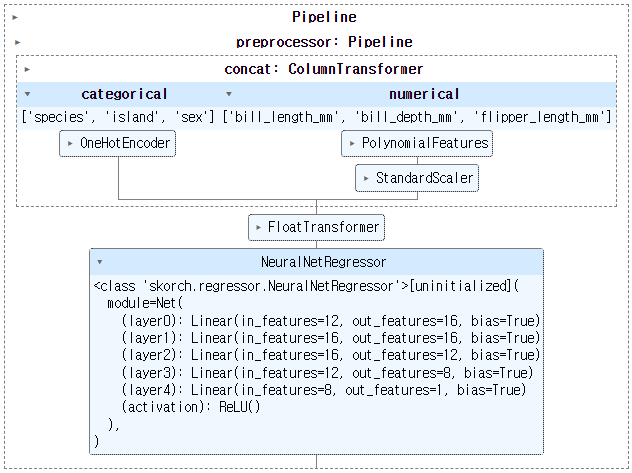
웬만한 매개변수는 모두
NeuralNetRegressor()에 들어갑니다.어떤 매개변수들이 있는지 출력해서 확인합니다.
1
model["ml"].get_params()
- 실행 결과
1
2
3
4
5
6
7
8
9
10
11
12
13
14
15
16
17
18
19
20
21
22
23
24
25
26
27
28
29
30
31
32
33
34
35
36
37
38
39{'_kwargs': {'optimizer__lr': 0.001},
'batch_size': 128,
'callbacks': [<__main__.InputShapeSetter at 0x7f4911406cd0>],
'callbacks__epoch_timer': <skorch.callbacks.logging.EpochTimer at 0x7f49745b2a50>,
'callbacks__print_log': <skorch.callbacks.logging.PrintLog at 0x7f49701261d0>,
'callbacks__print_log__floatfmt': '.4f',
'callbacks__print_log__keys_ignored': None,
'callbacks__print_log__sink': <function print>,
'callbacks__print_log__stralign': 'right',
'callbacks__print_log__tablefmt': 'simple',
'callbacks__train_loss': <skorch.callbacks.scoring.PassthroughScoring at 0x7f49745b2450>,
'callbacks__train_loss__lower_is_better': True,
'callbacks__train_loss__name': 'train_loss',
'callbacks__train_loss__on_train': True,
'callbacks__valid_loss': <skorch.callbacks.scoring.PassthroughScoring at 0x7f49745b24d0>,
'callbacks__valid_loss__lower_is_better': True,
'callbacks__valid_loss__name': 'valid_loss',
'callbacks__valid_loss__on_train': False,
'criterion': __main__.RMSELoss,
'dataset': skorch.dataset.Dataset,
'device': 'cuda:0',
'iterator_train': torch.utils.data.dataloader.DataLoader,
'iterator_valid': torch.utils.data.dataloader.DataLoader,
'lr': 0.01,
'max_epochs': 1000,
'module': Net(
(layer0): Linear(in_features=12, out_features=16, bias=True)
(layer1): Linear(in_features=16, out_features=16, bias=True)
(layer2): Linear(in_features=16, out_features=12, bias=True)
(layer3): Linear(in_features=12, out_features=8, bias=True)
(layer4): Linear(in_features=8, out_features=1, bias=True)
(activation): ReLU()
),
'optimizer': torch.optim.adam.Adam,
'optimizer__lr': 0.001,
'predict_nonlinearity': 'auto',
'train_split': <skorch.dataset.ValidSplit object at 0x7f497434cc90>,
'verbose': 1,
'warm_start': False}
- 실행 결과
3.2.3. train and validate (self)
X_train과 y_train만 사용해서 학습시킵니다.
1
model.fit(X_train, y_train.values.reshape(-1, 1).astype(np.float32))
- 실행 결과
1
2
3
4
5
6
7
8
9
10
11
12
13Re-initializing module because the following parameters were re-set: module__ninput.
Re-initializing criterion.
Re-initializing optimizer.
epoch train_loss valid_loss dur
------- ------------ ------------ ------
1 4280.8532 4388.5093 0.0188
2 4280.8443 4388.4990 0.0129
... (생략) ...
998 295.5285 270.6504 0.0106
999 295.5276 270.6288 0.0153
1000 295.5247 270.6030 0.0102
- 실행 결과
validation set을 입력하지 않았음에도 valid_loss가 출력됩니다.
train data의 20%를 validation set으로 따로 떼어 놓기 때문입니다.
맨 처음 전체 데이터의 60%만 train set으로 지정했습니다.
여기서 다시 80%만 학습에 투입되었으니 총 48%. 반도 안되는 데이터로 학습한 셈입니다.
train_split=None을 입력하면 모든 데이터를 다 학습에 투입하지만 validation 결과가 출력되지 않습니다.
learning curve는 신경망에서
.history속성을 추출해 확인할 수 있습니다.1
2
3
4
5history = model["ml"].history
train_loss = history[:, "train_loss"]
valid_loss = history[:, "valid_loss"]
plot_epoch(train_loss, valid_loss)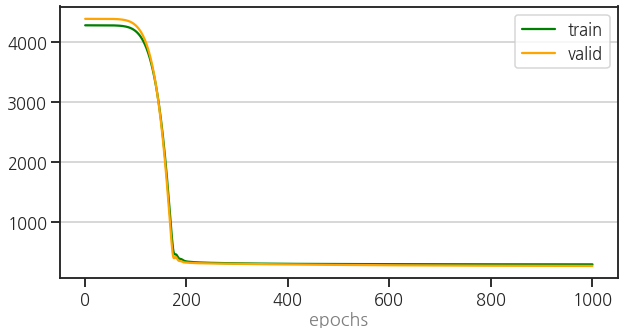
학습도 정상적으로 이루어졌습니다.
1
plot_parity3(model)
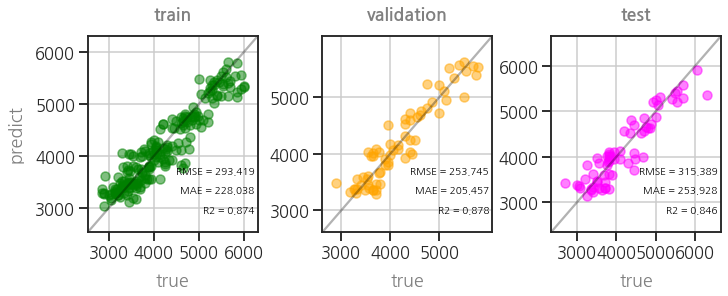
3.2.4. train and validate (predefined validation set)
먼저 준비한 validation set을 사용하려면
train_split에 validation set을 입력합니다.validation set은 skorch의
Dataset을 사용해 만듭니다.내친 김에 y data도 ML Pipeline에 만들기 좋은 형태, 즉 float32, (-1, 1) shape으로 변경해서 모아놓습니다.
1
2
3
4
5
6
7
8
9
10
11
12
13
14
15
16
17from skorch.dataset import Dataset
# ys (numpy)
y_train_np = y_train.values.reshape(-1, 1).astype(np.float32)
y_val_np = y_val.values.reshape(-1, 1).astype(np.float32)
y_test_np = y_test.values.reshape(-1, 1).astype(np.float32)
# predefined validation set
preprocessor = get_preprocessor()
X_val_pp = preprocessor.fit(X_train).transform(X_val)
valid_dataset = Dataset(X_val_pp, y_val_np)
# model training
model = get_model("nn", max_epochs=epochs, verbose=1, criterion=RMSELoss, optimizer=optim.Adam, optimizer__lr = 1e-3,
# predefined validataion set
train_split=predefined_split(valid_dataset))
model.fit(X_train, y_train_np)- 실행 결과
1
2
3
4
5
6
7
8
9
10
11
12
13Re-initializing module because the following parameters were re-set: module__ninput.
Re-initializing criterion.
Re-initializing optimizer.
epoch train_loss valid_loss dur
------- ------------ ------------ ------
1 4302.1941 4250.5781 0.0160
2 4302.1851 4250.5693 0.0175
... (생략) ...
998 280.9618 267.7317 0.0121
999 280.9596 267.7302 0.0122
1000 280.9580 267.7280 0.0141
- 실행 결과
learning curve를 확인합니다.
여기서 얻은 learning curve를 reference로 사용하겠습니다.
1
2
3
4
5history = model["ml"].history
train_loss_0 = history[:, "train_loss"]
valid_loss_0 = history[:, "valid_loss"]
plot_epoch(train_loss_0, valid_loss_0)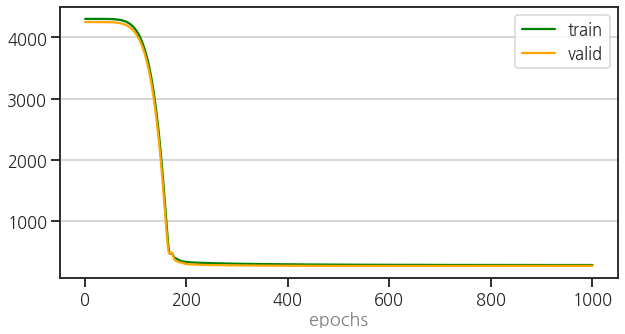
parity plot도 확인합니다.
1
plot_parity3(model)
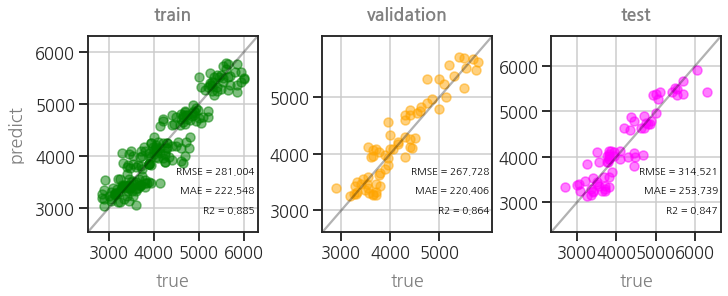
3.2.5. learning rate scheduler
skorch: Learning rate schedulers
Pega Devlog: Fast.ai의 fit_one_cycle 방법론 이해
callbacks에 learning late scheduler를 추가해 learning rate를 조정할 수 있습니다.
input dimension 조정을 위해 callbacks 기본값으로 InputShapeSetter()가 들어가 있습니다.
이를 삭제하지 않도록 유의하면서 learning rate scheduler를 추가합니다.
1
2
3
4
5
6
7
8
9
10
11
12from skorch.callbacks import LRScheduler
model = get_model("nn", max_epochs=epochs, verbose=1, criterion=RMSELoss, optimizer=optim.Adam, optimizer__lr = 1e-3,
train_split=predefined_split(valid_dataset), # predefined validataion set
callbacks=[# input dimension setter
("input_shape_setter", InputShapeSetter()),
# LR scheduler
("lr_scheduler", LRScheduler(policy=OneCycleLR, # LR scheduler
max_lr=0.1,
total_steps=epochs))])
model.fit(X_train, y_train_np)학습 과정은 생략하고 learning curve를 비교해서 봅니다.
1
2
3
4
5
6
7
8
9
10
11
12ax = plot_epoch(train_loss_0, valid_loss_0)
lines = ax.lines
for line in lines:
line.set_alpha(0.3)
history = model["ml"].history
train_loss = history[:, "train_loss"]
valid_loss = history[:, "valid_loss"]
ax = plot_epoch(train_loss, valid_loss, ax=ax)
handles, labels = ax.get_legend_handles_labels()
ax.legend(handles=handles, labels=labels, ncol=2, title="base OneCycleLR")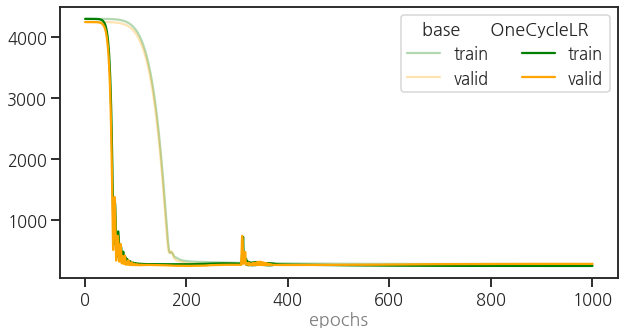
learning rate scheduler가 적용되어 학습 양상이 바뀌었습니다.
parity plot도 여전히 좋습니다.
1
plot_parity3(model)

3.2.6. early stopping
불필요하게 학습을 길게 하는 경향을 줄이고자 early stopping을 적용합니다.
EarlyStopping()을 callbacks에 추가하고 기준을 설정합니다.valid_loss가 20번 줄어들지 않으면 학습을 중단하도록
monitor="valid_loss",patience=20을 설정했습니다.1
2
3
4
5
6
7
8
9
10
11
12
13
14
15
16
17from skorch.callbacks import EarlyStopping
model = get_model("nn", max_epochs=epochs, verbose=1, criterion=RMSELoss, optimizer=optim.Adam, optimizer__lr = 1e-3,
train_split=predefined_split(valid_dataset), # predefined validataion set
callbacks=[# input dimension setter
("input_shape_setter", InputShapeSetter()),
# LR scheduler
("lr_scheduler", LRScheduler(policy=OneCycleLR,
max_lr=0.1,
total_steps=epochs)),
# early stopping
("early_stopping", EarlyStopping(monitor="valid_loss",
patience=20))])
model.fit(X_train, y_train.values.reshape(-1, 1).astype(np.float32))learning curve를 비교합니다.
1
2
3
4
5
6
7
8
9
10
11
12
13ax = plot_epoch(train_loss_0, valid_loss_0)
lines = ax.lines
for line in lines:
line.set_alpha(0.3)
history = model["ml"].history
train_loss = history[:, "train_loss"]
valid_loss = history[:, "valid_loss"]
ax = plot_epoch(train_loss, valid_loss, ax=ax)
handles, labels = ax.get_legend_handles_labels()
ax.legend(handles=handles, labels=labels, ncol=2, title="base LRS+ES")
ax.set_xlim(0, 200)
parity plot도 정상적입니다.
1
plot_parity3(model)
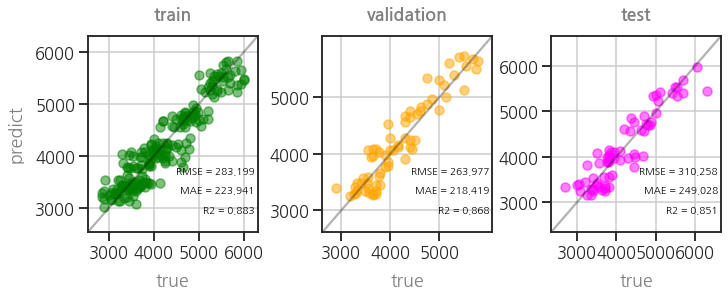
3.2.7. Saving and Loading (manual)
모델 파라미터를 pickle 형식으로 저장하고 불러올 수 있습니다.
1
2# save parameters
model["ml"].save_params(f_params="nn_params.pkl")모델을 새로 만들면 paramter를 불러오기 전에 초기화하는 과정이 필요합니다.
.initialize()를 사용합니다.1
2
3
4# load parameters
model_new = get_model(method="nn")
model_new["ml"].initialize()
model_new["ml"].load_params(f_params="nn_params.pkl")새로 만든 모델에 parameter를 불러와서 적용합니다.
단, 신경망 parameter에만 해당하는 상황이므로 preprocessor는 기존 모델의 preprocessor를 사용합니다.
1
2
3
4
5
6# check reproducibility
y_pred_train = model_new["ml"].predict(model["preprocessor"].transform(X_train))
y_pred_val = model_new["ml"].predict(model["preprocessor"].transform(X_val))
y_pred_test = model_new["ml"].predict(model["preprocessor"].transform(X_test))
plot_parity3(model_new, preds=[y_pred_train, y_pred_val, y_pred_test])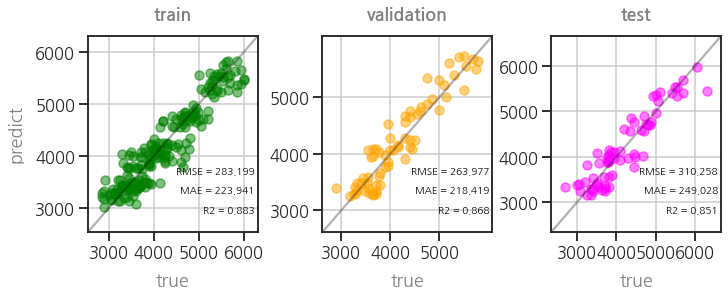
학습을 하지 않았음에도 parity plot이 똑같이 재현되었습니다.
3.2.8. Saving and Loading (callbacks)
callback을 이용하면 valid loss가 줄어들때마다 저장할 수 있습니다.
valid loss가 줄어들때마다 저장하는
cp와 epoch마다 저장하는train_end_cp를 동시에 지정합니다.exp1폴더를 만들어 여기에 함께 저장하도록 합니다.1
2
3
4
5
6
7
8
9
10
11
12
13
14
15
16
17
18
19
20
21
22
23
24
25
26from skorch.callbacks import Checkpoint, TrainEndCheckpoint
# save the model parameters, optimizer, and history
cp = Checkpoint(dirname='exp1')
train_end_cp = TrainEndCheckpoint(dirname='exp1')
model = get_model("nn", max_epochs=epochs, verbose=1, criterion=RMSELoss, optimizer=optim.Adam, optimizer__lr = 1e-3,
train_split=predefined_split(valid_dataset),
callbacks=[# input dimension setter
("input_shape_setter", InputShapeSetter()),
# LR scheduler
("lr_scheduler", LRScheduler(policy=OneCycleLR,
max_lr=0.1,
total_steps=epochs)),
# early stopping
("early_stopping", EarlyStopping(monitor="valid_loss",
patience=20)),
# Checkpoints
("checkpoint", cp),
("train_end_checkpoint", train_end_cp)
])
model.fit(X_train, y_train.values.reshape(-1, 1).astype(np.float32))- 실행 결과
1
2
3
4
5
6
7
8
9
10
11
12
13
14
15
16
17
18
19
20
21Re-initializing module because the following parameters were re-set: module__ninput.
Re-initializing criterion.
Re-initializing optimizer.
epoch train_loss valid_loss cp lr dur
------- ------------ ------------ ---- ------ ------
1 4301.9097 4250.2661 + 0.0040 0.0093
2 4301.8677 4250.2241 + 0.0040 0.0107
3 4301.8278 4250.1914 + 0.0040 0.0083
4 4301.7949 4250.1577 + 0.0040 0.0111
... (생략) ...
96 294.3520 265.7108 0.0260 0.0112
97 296.6454 273.7495 0.0264 0.0098
98 290.3884 289.0570 0.0268 0.0071
99 289.6089 273.4566 0.0273 0.0093
100 284.6194 261.8893 + 0.0277 0.0092
101 290.8631 262.4448 0.0281 0.0107
102 289.3116 275.2869 0.0286 0.0077
103 286.5198 278.3972 0.0290 0.0075
104 283.5437 266.5125 0.0295 0.0106
- 실행 결과
cp라는 열이 하나 생겼고, 여기 +가 붙은 곳들이 있습니다.
valid_loss가 기존 기록보다 작아진 지점입니다.
History도 파일에서 불러와서 그립니다.
부를 때는
skorch.history.History를 사용합니다.세 개의 learning curve를 겹쳐 그리느라 코드가 다소 복잡해졌습니다.
1
2
3
4
5
6
7
8
9
10
11
12
13
14
15
16
17
18
19
20
21
22
23
24
25from skorch.history import History
# base plot
ax = plot_epoch(train_loss_0, valid_loss_0)
lines = ax.lines
for line in lines:
line.set_alpha(0.3)
# history
history = History().from_file("./exp1/history.json")
train_loss = history[:, "train_loss"]
valid_loss = history[:, "valid_loss"]
ax = plot_epoch(train_loss, valid_loss, ax=ax)
# event_cp : cp == True
epoch = history[:, "epoch"]
event_cp = history[:, "event_cp"]
df_cp = pd.DataFrame({"epoch":epoch, "event_cp":event_cp, "train_loss":train_loss, "valid_loss":valid_loss})
df_cp = df_cp.loc[df_cp["event_cp"]==True]
ax.scatter(df_cp["epoch"], df_cp["train_loss"], fc=c_train, alpha=0.5, label="train_cp")
ax.scatter(df_cp["epoch"], df_cp["valid_loss"], fc=c_val, alpha=0.5, label="valid_cp")
ax.legend(ncol=3, title="base LRS+ES checkpoint", loc="center right")
ax.set_xlim(0, 200)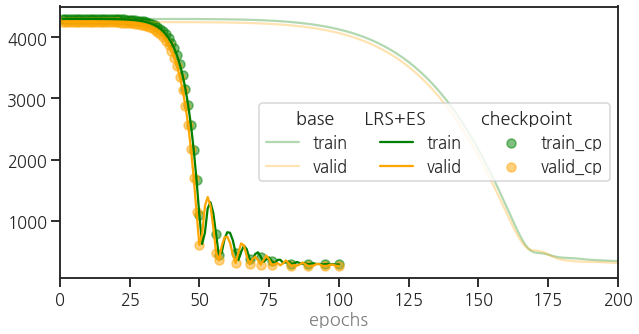
희미하게 그려진 것은 skorch에 validation set을 사용한 base line입니다.
그리고 Learning Rate Scheduler와 Early Stopping을 적용한 것을 LRS + ES로 표기했습니다.
앞에서와 같이 학습이 훨씬 빨리 끝났습니다.
그리고 이 중 checkpoint가 적용된 것을 scatter plot으로 표현했습니다.
one-cycle-fit의 영향으로 learning curve가 요동치는 와중에서도 train과 valid에서 단조 감소하는 모습만이 기록되었습니다.
3.2.9. valid loss가 가장 적었던 checkpoint 불러서 learning rate 낮추기
각 checkpoint에서는 history 외에도 criterion, optimizer, parameter 등의 상태를 저장합니다.
Colab 왼쪽의 폴더 모양을 클릭해 저장한 파일을 확인하면 볼 수 있습니다.
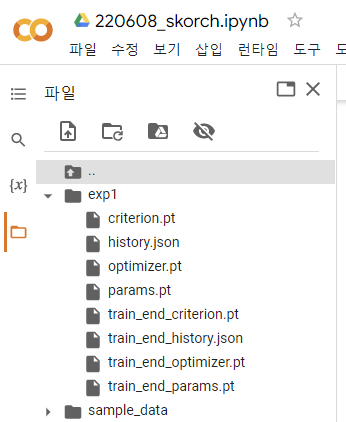
학습이 과하게 진행되어 overfitting이 되면 지나가버린 과거의 최적점이 아쉽습니다.
지나친 최적점을 불러와서 훨씬 낮은 learning rate로 살살 학습시키면 더 좋을 것 같습니다.
- 이 때 skorch에서 제공하는 LoadInitState를 사용할 수 있습니다.
cp = Checkpoint()로 저장된 위치를 지정하고,load_state = LoadInitState(cp)로 불러와 상태를 불러옵니다.- 마지막으로
callbacks에cp와load_state를 추가합니다.1
2
3
4
5
6
7
8
9
10
11
12
13
14
15
16
17
18
19
20
21
22
23
24from skorch.callbacks import LoadInitState
cp = Checkpoint(dirname='exp1')
load_state = LoadInitState(cp)
model = get_model("nn", max_epochs=epochs, verbose=1, criterion=RMSELoss, optimizer=optim.Adam,
# learning rate 조정
optimizer__lr = 1e-5,
# predefined validataion set
train_split=predefined_split(valid_dataset),
callbacks=[# input dimension setter
("input_shape_setter", InputShapeSetter()),
# early stopping
("early_stopping", EarlyStopping(monitor="valid_loss",
patience=100)),
# Checkpoints
("checkpoint", cp),
("load_initial_state", load_state)
])
model.fit(X_train, y_train.values.reshape(-1, 1).astype(np.float32))
3.2.10. Saving and Loading (model itself)
모델 전체를 저장할 때는 pickle을 권장하고 있습니다.
pickle.dump()와pickle.load()를 사용해 모델을 읽고 씁니다.1
2
3
4
5
6
7# saving
with open('skorch_dl.pkl', 'wb') as f:
pickle.dump(model, f)
# loading
with open('skorch_dl.pkl', 'rb') as f:
model_pkl = pickle.load(f)저장한 모델을 불러오면서 이름을 model_pkl로 바꿨습니다.
이 모델의 parity plot을 그려서 잘 저장되었고 불러졌는지 확인합니다.
1
2# check reproducibility
plot_parity3(model=model_pkl)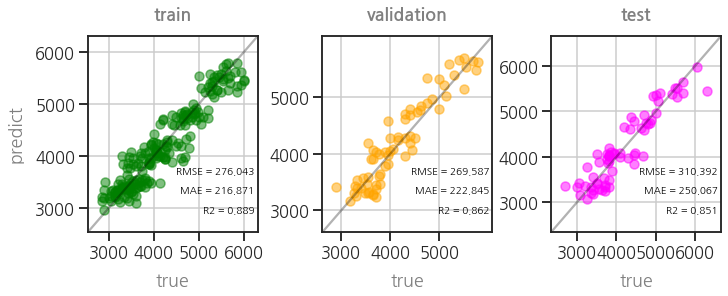
추가 학습 없이도 원래의 성능이 확인되었습니다.
4. 정리 : skorch ML pipeline
- 이제까지 세 편의 글에 걸쳐 데이터를 정리한 후,
- scikit-learn preprocessor를 만들고,
- PyTorch neural network를 구축한 후,
- skorch로 이들을 엮은 뒤 callbacks로 여러 옵션을 뿌렸습니다.
- 최종적으로 사용한 코드가 여기 저기 흩뿌려져 있어 활용이 어려울 듯도 싶습니다.
- skorch ML pipeline 코드를 아래에 정리합니다.
- 목적은 Ctrl+C/V와 약간의 수정으로 사용하는 것입니다.
4.1. skorch ML pipeline
scikit-learn preprocessor
1
2
3
4
5
6
7
8
9
10
11
12
13
14
15
16
17
18
19
20
21
22
23
24
25
26
27
28
29
30
31
32
33
34
35
36
37
38
39
40
41
42
43
44# preprocessors
from sklearn.preprocessing import OneHotEncoder
from sklearn.preprocessing import FunctionTransformer
from sklearn.preprocessing import StandardScaler
from sklearn.preprocessing import PolynomialFeatures
# pipeline
from sklearn.pipeline import Pipeline
from sklearn.compose import ColumnTransformer
from sklearn.base import BaseEstimator, TransformerMixin
# Preprocessings for Categorical and Numerical features
def get_concat(cols_cat=cols_cat, cols_num=cols_num, degree=1):
# categorical features: one-hot encoding
cat_features = cols_cat
cat_transformer = OneHotEncoder(sparse=False, handle_unknown="ignore")
# numerical features: standard scaling & polynomial features
num_features = cols_num
num_transformer = Pipeline(steps=[("polynomial", PolynomialFeatures(degree=degree)),
("scaler", StandardScaler())])
numcat = ColumnTransformer(transformers=[("categorical", cat_transformer, cat_features),
("numerical", num_transformer, num_features)])
return numcat
# Float64 to Float32 for PyTorch
class FloatTransformer(BaseEstimator, TransformerMixin):
def __init__(self):
pass
def fit(self, X, y=None):
return self
def transform(self, X):
return np.array(X, dtype=np.float32)
# preprocessing Pipeline
def get_preprocessor(cols_cat=cols_cat, cols_num=cols_num, degree=1):
concat = get_concat(cols_cat=cols_cat, cols_num=cols_num, degree=degree)
ft = FloatTransformer()
pipeline= Pipeline(steps=[("concat", concat),
("float64to32", ft)])
return pipelinePyTorch Neural Network
1
2
3
4
5
6
7
8
9
10
11
12
13
14
15
16
17
18
19
20
21
22
23
24
25
26
27
28
29
30
31
32import torch
from torch import nn
from torch import optim
# neural network: ninput(12)-16-16-12-8-1
class Net(nn.Module):
def __init__(self, ninput=12):
super().__init__()
self.layer0 = nn.Linear(ninput, 16)
self.layer1 = nn.Linear(16, 16)
self.layer2 = nn.Linear(16, 12)
self.layer3 = nn.Linear(12, 8)
self.layer4 = nn.Linear(8, 1)
self.activation = nn.ReLU()
def forward(self, x):
x = self.activation(self.layer0(x))
x = self.activation(self.layer1(x))
x = self.activation(self.layer2(x))
x = self.activation(self.layer3(x))
x = self.layer4(x)
return x
# loss: RMSE
class RMSELoss(nn.Module):
def __init__(self, eps=1e-6):
super().__init__()
self.mse = nn.MSELoss()
self.eps = eps
def forward(self, true, pred):
loss = torch.sqrt(self.mse(true, pred) + self.eps)
return lossskorch ML Pipeline
1
2
3
4
5
6
7
8
9
10
11
12
13
14
15
16
17
18
19
20
21
22
23
24
25
26
27
28
29
30
31
32
33
34
35
36
37
38
39
40
41
42
43
44
45
46# machine learning models
from sklearn.linear_model import LinearRegression
from sklearn.ensemble import RandomForestRegressor
# embedding pytorch model in scikit-learn Pipeline
from skorch import NeuralNetRegressor
from skorch.helper import predefined_split
# callbacks
from skorch.callbacks import Callback
from skorch.callbacks import LRScheduler
from skorch.callbacks import EarlyStopping
from skorch.callbacks import Checkpoint, TrainEndCheckpoint
# dynamic input size of the PyTorch module
class InputShapeSetter(Callback):
def on_train_begin(self, net, X, y):
net.set_params(module__ninput=X.shape[1])
# save the model parameters, optimizer, and history
cp = Checkpoint(dirname='exp_test')
train_end_cp = TrainEndCheckpoint(dirname='exp_test')
# skorch ML pipeline
def get_model(method="lr", device=device, cols_cat=cols_cat, cols_num=cols_num, degree=1,
callbacks=[("input_shape_setter", InputShapeSetter()),
("lr_scheduler", LRScheduler(policy=OneCycleLR, max_lr=0.1, total_steps=epochs)),
("early_stopping", EarlyStopping(monitor="valid_loss", patience=20)),
("checkpoint", cp), ("train_end_checkpoint", train_end_cp)],
**kwargs):
if method == "lr":
ml = LinearRegression(fit_intercept=True)
elif method == "rf":
ml = RandomForestRegressor(random_state=rng)
elif method == "nn":
ml = NeuralNetRegressor(Net(), device=device, callbacks=callbacks, **kwargs)
else:
print("# 'method' should be in ['lr', 'rf', 'nn'].")
return None
preprocessor = get_preprocessor(cols_cat=cols_cat, cols_num=cols_num, degree=degree)
model = Pipeline([("preprocessor", preprocessor),
("ml", ml)])
return model
4.2. Visualizations
learning curve
1
2
3
4
5
6
7
8
9
10
11
12
13
14
15
16
17
18
19
20
21
22
23def plot_epoch(history=None, loss_trains=None, loss_vals=None, ax=None):
if any([history, loss_trains]) == False:
print("# one of 'history' and 'loss_trains' has to be used!")
return ax
if ax == None:
fig, ax = plt.subplots(figsize=(10, 5))
if loss_trains == None:
loss_trains = history[:, "train_loss"]
if history != None and loss_vals == None:
loss_vals = history[:, "valid_loss"]
ax.plot(list(range(1, len(loss_trains)+1)), loss_trains, c=c_train, label="train")
if loss_vals != None:
ax.plot(list(range(1, len(loss_vals)+1)), loss_vals, c=c_val, label="valid")
ax.grid(axis="y")
ax.set_xlabel("epochs", fontdict=font_label)
ax.legend()
return axparity plots
1
2
3
4
5
6
7
8
9
10
11
12
13
14
15
16def plot_parity3(model, target=["train", "val", "test"], figsize=(10, 4),
Xs=None, trues=None, preds=None, colors=None):
if not Xs:
Xs = [eval(f"X_{t}") for t in target]
if not trues:
trues = [eval(f"y_{t}") for t in target]
if not preds:
preds = [model.predict(X) for X in Xs]
if not colors:
colors = [eval(f"c_{t}") for t in target]
fig, axs = plt.subplots(ncols=len(target), figsize=figsize, constrained_layout=True)
for ax, true, pred, c, title in zip(axs, trues, preds, colors, titles):
plot_parity(true, pred, ax=ax, scatter_kws={"fc":c, "ec":c, "alpha":0.5}, title=title)
if ax != axs[0]:
ax.set_ylabel("")
4.3. test run
정의한 함수들로 예제를 돌려봅니다.
1
2
3
4
5
6
7
8
9
10
11
12
13
14
15
16# predefined validation set
preprocessor = get_preprocessor()
X_val_pp = preprocessor.fit(X_train).transform(X_val)
valid_dataset = Dataset(X_val_pp, y_val_np)
# ML pipeline preparation
model_test = get_model("nn", max_epochs=epochs, verbose=1, criterion=RMSELoss, optimizer=optim.Adam, optimizer__lr = 1e-3,
train_split=predefined_split(valid_dataset))
model_test.fit(X_train, y_train_np)
# learning curve
history = History().from_file("./exp_test/history.json")
ax = plot_epoch(history)
# parity plots
plot_parity3(model_test)- 실행 결과
1
2
3
4
5
6
7
8
9
10
11
12
13Re-initializing module because the following parameters were re-set: module__ninput.
Re-initializing criterion.
Re-initializing optimizer.
epoch train_loss valid_loss cp lr dur
------- ------------ ------------ ---- ------ ------
1 4301.9874 4250.3501 + 0.0040 0.0135
2 4301.9537 4250.3169 + 0.0040 0.0139
... (생략) ...
110 283.9839 270.7625 0.0322 0.0108
111 282.3574 270.6689 0.0326 0.0145
Stopping since valid_loss has not improved in the last 20 epochs.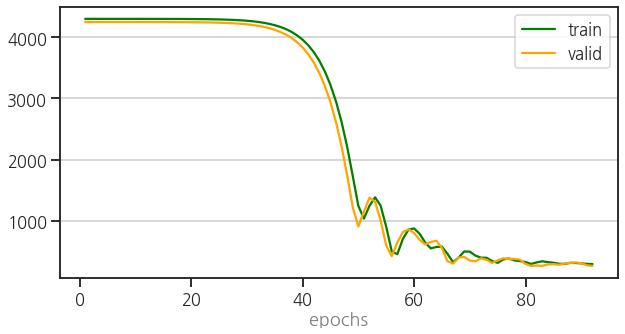
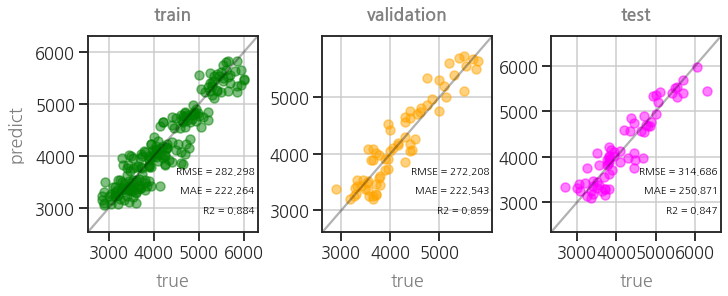
- 실행 결과
잘 돌아갑니다. :)
전체를 실행해볼 수 있는 코드는 여기 있습니다: Notebook
